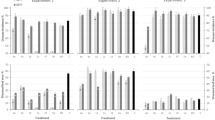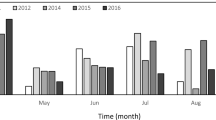Abstract
In a field experiment conducted over two growing seasons, the effectiveness and phytotoxicity of inorganic fungicides such as sulphur, lime sulphur, copper, silicon and Armicarb (a new formulation of potassium bicarbonate) was compared with water for the control of primary apple scab infections in Belgium on high, medium and low scab-susceptible cultivars (cvs ‘Pinova’, ‘Pirouette’ and ‘Reinette des Capucins’, respectively). In order to drastically reduce the amount of fungicide applied in the orchard, two approaches were used: (1) a strategy involving spraying during the infection process, before fungal penetration and (2) a tunnel sprayer machine for treatment applications. Under field conditions highly favourable for disease, low rates of elemental sulphur (31.8 and 38.6 kg ha−1 year−1 in 2005 and 2006, respectively) combined with low rates of copper (2.1 kg ha−1 year−1 in both years) provided the best scab control and reduced scab severity on the fruits of cv. ‘Pinova’ by 97 and 98% compared with water control in 2005 and 2006, respectively. Lime sulphur was much more effective than wettable sulphur and appeared to be efficient at temperatures below 10°C, but its effectiveness against apple scab decreased if the treatments were applied 12–24 h later than in the ‘during-infection’ spray strategy. Armicarb used alone significantly reduced apple scab severity on the leaves and fruits of the three cultivars compared with the water control. Its effectiveness was as good as wettable sulphur applied using the same timing and dosage. Silicon reduced apple scab on fruits very slightly, but not on leaves. The amounts of wettable sulphur, lime sulphur, copper, silicon and potassium bicarbonate used in this experiment to control apple scab were not phytotoxic, did not increase fruit russet, did increase the yield of each cultivar and did not affect summer density of the beneficial Typhlodromus pyri. The potential and limitations of ‘during-infection’ spraying as a protection strategy against apple scab in organic farming are discussed.
Similar content being viewed by others
References
Anon. (2007). Council Regulation (EEC) No 2092/91 of 24 June 1991 on organic production of agricultural products and indications referring thereto on agricultural products and foodstuffs. Retrieved September 30, 2007 from European Union Web site: http://europa.eu/scadplus/leg/en/lvb/l21118.htm
Belanger, R. R., Bowen, P. A., Ehret, D., & Menzies, J. G. (1995). Soluble silicon: Its role in crop and disease management of greenhouse crops. Plant Disease, 79, 329–336.
Beresford, R. M., Wearing, C. H., Marshall, R. R., Shaw, P. W., Spink, M. & Wood P. N. (1996). Slaked lime, baking soda and mineral oil for black spot and powdery mildew control in apples. Proceedings of the 49th New Zealand Plant Protection Conference. Quality Hotel Rutherford, Nelson, New Zealand, pp. 106–113, August.
Croxall, H. E., Gwynne, D. C., & Jenkins, J. E. E. (1952). The rapid assessment of apple scab on fruit. Plant Pathology, 2, 89–92.
Ellis, M. A., Ferree, D. C., Funt, R. C., & Madden, L. V. (1998). Effects of an apple scab-resistant cultivar on use patterns of inorganic and organic fungicides and economics of disease control. Plant Disease, 82, 428–433.
Ellis, M. A., Madden, L. V., Wilson, L. L., & Ferree, D. C. (1994). Evaluations of organic and conventional fungicide programs for control of apple scab in Ohio. Ohio Agricultural Research Development Centre, Research Circular, 298, 63–68.
Funt, R. C., Ellis, M. A., & Madden, L. V. (1990). Economic analysis of protectant and disease-forecast-based fungicide spray programs for control of apple scab and grape black rot in Ohio. Plant Disease, 74, 638–642.
Gessler, C., Patocchi, A., Sansavini, S., Tartarini, S., & Gianfranceschi, L. (2006). Venturia inaequalis resistance in apple. Critical Reviews in Plant Sciences, 25, 473–503.
Hindorf, H., Rövekamp, I. F., & Henseler, K. (2000). Decision aids for apple scab warning services (Venturia inaequalis) in Germany. OEPP/EPPO Bulletin, 30, 59–64.
Holb, I. J., & Heijne, B. (2001). Evaluating primary scab control in organic apple production. Gartenbauwissenschaft, 66, 254–261.
Holb, I. J., De Jong, P. F., & Heijne, B. (2003). Efficacy and phytotoxicity of lime sulphur in organic apple production. Annals of Applied Biology, 142, 225–233.
Holb, I. J., Heijne, B., & Jeger, M. J. (2005a). The widespread occurrence of overwintered conidial inoculum of Venturia inaequalis on shoots and buds in organic and integrated apple orchards across the Netherlands. European Journal of Plant Pathology, 111, 157–168.
Holb, I. J., Heijne, B., Withagen, J. C. M., Gall, J. M., & Jeger, M. J. (2005b). Analysis of summer epidemic progress of apple scab at different apple production systems in the Netherlands and Hungary. Phytopathology, 95, 1001–1020.
Holb, I. J. (2006). Effect of six sanitation treatments on leaf litter density, ascospore production of Venturia inaequalis and scab incidence in integrated and organic apple orchards. European Journal of Plant Pathology, 115, 293–307.
Horst, R. K., Kawamoto, S. O., & Porter, L. L. (1992). Effect of sodium bicarbonate and oils on the control of powdery mildew and black spot of roses. Plant Disease, 76, 247–251.
Ilhan, K., Arslan, U., & Karabulut, O. A. (2006). The effect of sodium bicarbonate alone or in combination with a reduced dose of tebuconazole on the control of apple scab. Crop Protection, 25, 963–967.
Jamar, L., & Lateur, M. (2007). Strategies to reduce copper use in organic apple production, ISHS. Acta Horticulturae, 737, 113–120.
Jamar, L., Lefrancq, B., & Lateur, M. (2007). Control of apple scab (Venturia inaequalis) with bicarbonate salts under controlled environment. Journal of Plant Diseases and Protection, 115, 221–227.
Kreiter, S., Sentenac, G., Barthes, D., & Auger, P. (1998). Toxicity of four fungicides to the predacious mite Typhlodromus pyri (Acari: Phytoseiidae). Journal of Economic Entomology, 91, 802–811.
Lateur, M., Wagemans, C., & Populer, C. (1999). Evaluation of fruit tree genetic resources as sources of polygenic scab resistance in apple breeding. ISHS. Acta Horticulturae, 484, 35–42.
Lateur, M. & Blazek, J. (2002, May). Evaluation descriptors for Malus. Report of a Working Group on Malus/Pyrus. Second meeting, Dresden-Pillnitz, Germany. International Plant Genetic Resources Institute, Rome, Italy, pp. 76–82.
MacHardy, W. E., & Gadoury, D. M. (1989). A revision of Mills’s criteria for predicting apple scab infection periods. Phytopathology, 79, 304–310.
MacHardy, W. E. (1996). Apple scab, biology, epidemiology and management. St Paul, Minnesota, USA: APS Press.
MacHardy, W., Gadoury, D. M., & Gessler, C. (2001). Parasitic and biological fitness of Venturia inaequalis: Relationship to disease management strategies. Plant Disease, 85, 1036–1051.
Markoyiannaki-Printzioui, D., Papaioannou-Souliotis, P., Zeginis, G., & Giatropoulos, C. (2000). Observations on acarofauna in four apple orchards of Central Greece. I. Incidence of pedoclimatic conditions and agricultural techniques on phytoseiid mites (Acari: Phytoseiidae). Acarologia, 41, 109–126.
Mills, W. D. (1947). Effects of sprays of lime sulphur and of elemental sulphur on apple in relation to yield. Cornell Experiment Station, 273, 38 p.
Montag, J., Schreiberg, L., & Schönherr, J. (2005). An in vitro study on the postinfection activities of hydrated lime and lime sulphur against apple scab (Venturia inaequalis). Journal of Phytopathology, 153, 485–491.
Palmer, J. W., Davies, S. B., Shaw, P. W., & Wünsche, J. N. (2003). Growth and fruit quality of ‘Braeburn’ apple (Malus domestica) trees as influenced by fungicide programmes suitable for organic production. New Zealand Journal of Crop and Horticultural Science, 31, 169–177.
Schnug, E. (1998). Sulphur in agroecosystems. Dordrecht: Kluwer.
Schulze, K., & Schönherr, J. (2003). Calcium hydroxide, potassium carbonate and alkyl polyglycosides prevent spore germination and kill germ tubes of apple scab (Venturia inaequalis). Journal of Plant Diseases and Protection, 110, 36–45.
Simon, S., Lauri, P. E., Brun, L., Defrance, H., & Sauphanor, B. (2006). Does manipulation of fruit-tree architecture affect the development of pests and pathogens? A case study in an organic apple orchard. Journal of Horticultural Science & Biotechnology, 81, 765–773.
Smereka, K. J., MacHardy, W. E., & Kausch, A. P. (1987). Cellular differentiation in Venturia inaequalis ascospores during germination and penetration of apple leaves. Canadian Journal of Botany, 65, 2549–2561.
Trapman, M., & Polfliet, C. M. (1997). Management of primary infections of apple scab with the simulation program RIMpro: Review of four years field trials. IOBC Bulletin, 20, 241–250.
Tweedy, B. G. (1981). Inorganic sulphur as a fungicide. Residue Reviews, 78, 44–68.
Williams, J. S., & Cooper, R. M. (2004). The oldest fungicide and newest phytoalexin—A reappraisal of the fungitoxicity of elemental sulphur. Plant Pathology, 53, 263–279.
Acknowledgements
This research is funded by the Ministry of the Walloon Regional Government, General Department of Agriculture, Research Direction, project RW D31-1105. The authors would like to thank Dr Robert Oger (CRA-W, Gembloux) for his valuable help in the statistical analysis, Ir Piet Creemers (PCF-KOG, St Truiden) for stimulating discussions during this study and B. Pahaut for his excellent co-operation in this research.
Author information
Authors and Affiliations
Corresponding author
Rights and permissions
About this article
Cite this article
Jamar, L., Lefrancq, B., Fassotte, C. et al. A during-infection spray strategy using sulphur compounds, copper, silicon and a new formulation of potassium bicarbonate for primary scab control in organic apple production. Eur J Plant Pathol 122, 481–493 (2008). https://doi.org/10.1007/s10658-008-9315-0
Received:
Accepted:
Published:
Issue Date:
DOI: https://doi.org/10.1007/s10658-008-9315-0




